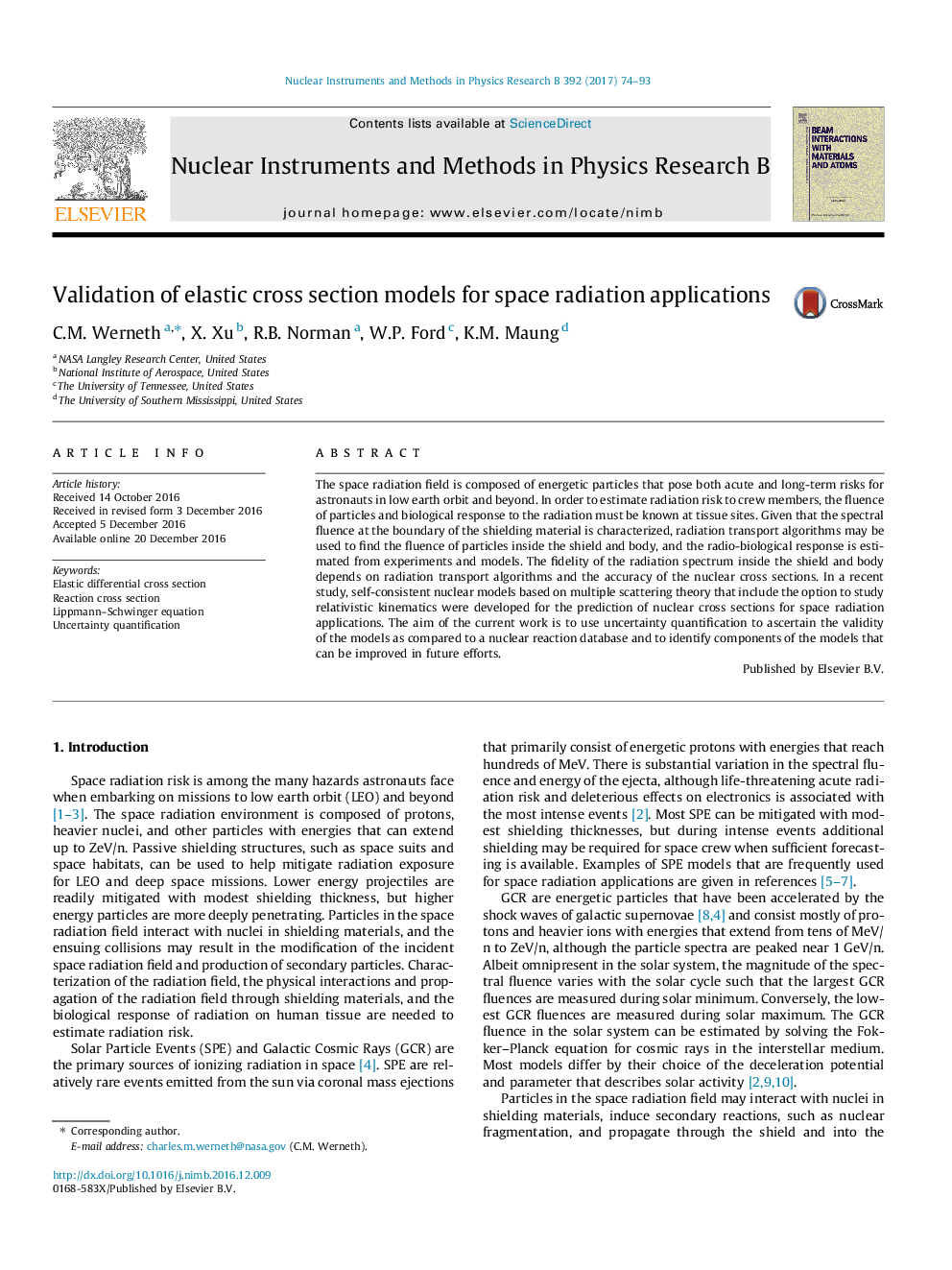| کد مقاله | کد نشریه | سال انتشار | مقاله انگلیسی | نسخه تمام متن |
|---|---|---|---|---|
| 5467634 | 1518630 | 2017 | 20 صفحه PDF | دانلود رایگان |
عنوان انگلیسی مقاله ISI
Validation of elastic cross section models for space radiation applications
ترجمه فارسی عنوان
اعتبار سنجی مدل های مقطعی کششی برای کاربردهای فضایی فضا
دانلود مقاله + سفارش ترجمه
دانلود مقاله ISI انگلیسی
رایگان برای ایرانیان
کلمات کلیدی
ترجمه چکیده
میدان تابش فضا از ذرات پر انرژی تشکیل شده است که خطرات حاد و بلندمدت فضانوردان را در مدار زمین کم و بیش از حد ایجاد می کند. به منظور ارزیابی خطر صدمه به اعضای خدمه، فلونیزاسیون ذرات و پاسخ بیولوژیکی به تابش باید در سایت های بافت شناخته شده باشد. با توجه به این که فلوئنت طیفی در مرز مواد محافظ مشخص شده است، الگوریتم های انتقال تابش می تواند برای یافتن فلج شدن ذرات داخل سپر و بدن استفاده شود و پاسخ رادیو بیولوژیکی از آزمایشات و مدل ها برآورد شود. وفاداری طیف تابش در داخل سپر و بدن بستگی به الگوریتم های انتقال تابش و دقت بخش های هسته ای دارد. در یک مطالعه اخیر، مدل های خودمختار هسته ای مبتنی بر نظریه پراکندگی چندگانه که شامل گزینه مطالعه سینماتیک نسبیتی هستند، برای پیش بینی مقاطع هسته ای برای کاربردهای فضایی طراحی شده است. هدف از کار فعلی، استفاده از اندازه گیری عدم اطمینان برای اطمینان از اعتبار مدل ها در مقایسه با پایگاه داده واکنش هسته ای و شناسایی اجزای مدل هایی است که می تواند در تلاش های آینده بهبود یابد.
موضوعات مرتبط
مهندسی و علوم پایه
مهندسی مواد
سطوح، پوششها و فیلمها
چکیده انگلیسی
The space radiation field is composed of energetic particles that pose both acute and long-term risks for astronauts in low earth orbit and beyond. In order to estimate radiation risk to crew members, the fluence of particles and biological response to the radiation must be known at tissue sites. Given that the spectral fluence at the boundary of the shielding material is characterized, radiation transport algorithms may be used to find the fluence of particles inside the shield and body, and the radio-biological response is estimated from experiments and models. The fidelity of the radiation spectrum inside the shield and body depends on radiation transport algorithms and the accuracy of the nuclear cross sections. In a recent study, self-consistent nuclear models based on multiple scattering theory that include the option to study relativistic kinematics were developed for the prediction of nuclear cross sections for space radiation applications. The aim of the current work is to use uncertainty quantification to ascertain the validity of the models as compared to a nuclear reaction database and to identify components of the models that can be improved in future efforts.
ناشر
Database: Elsevier - ScienceDirect (ساینس دایرکت)
Journal: Nuclear Instruments and Methods in Physics Research Section B: Beam Interactions with Materials and Atoms - Volume 392, 1 February 2017, Pages 74-93
Journal: Nuclear Instruments and Methods in Physics Research Section B: Beam Interactions with Materials and Atoms - Volume 392, 1 February 2017, Pages 74-93
نویسندگان
C.M. Werneth, X. Xu, R.B. Norman, W.P. Ford, K.M. Maung,
